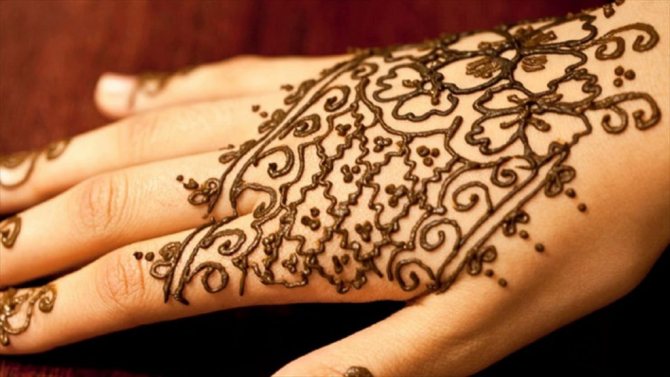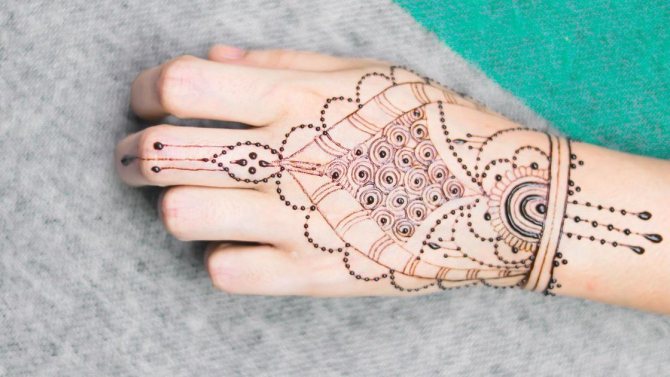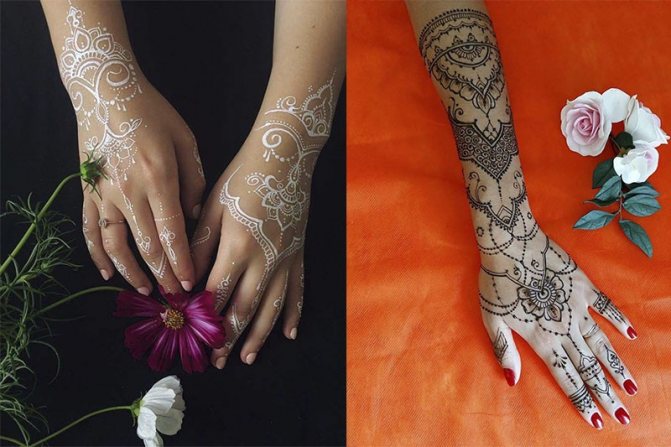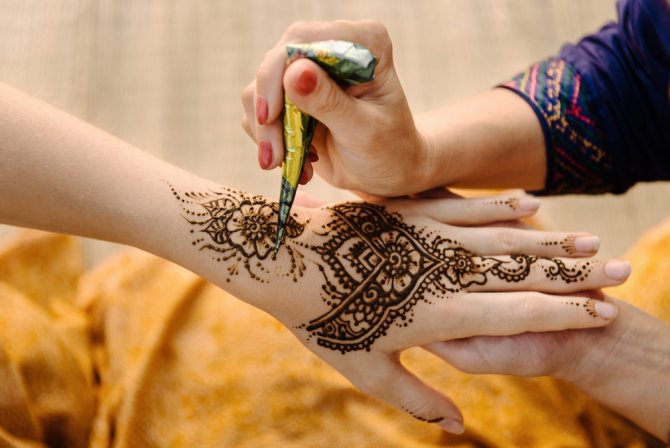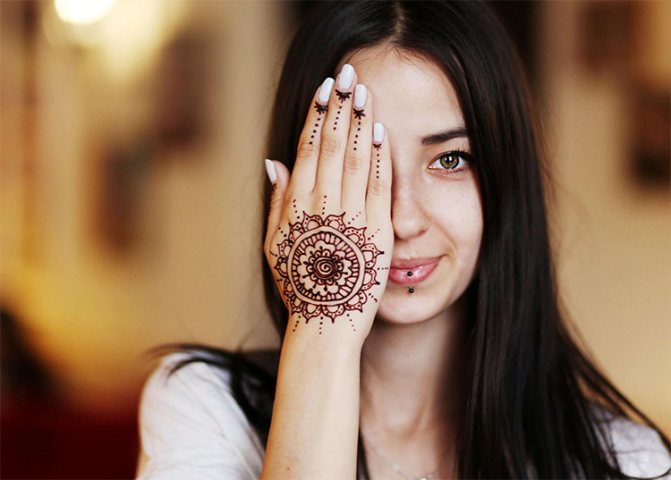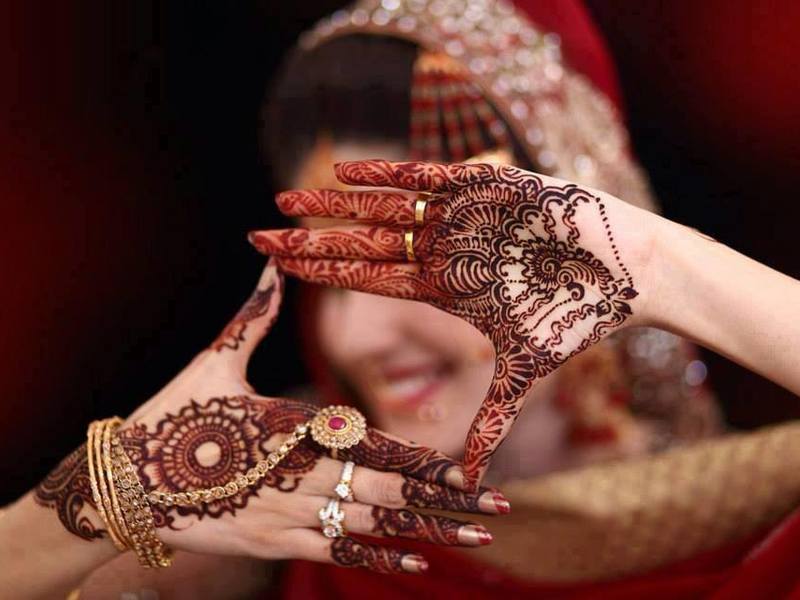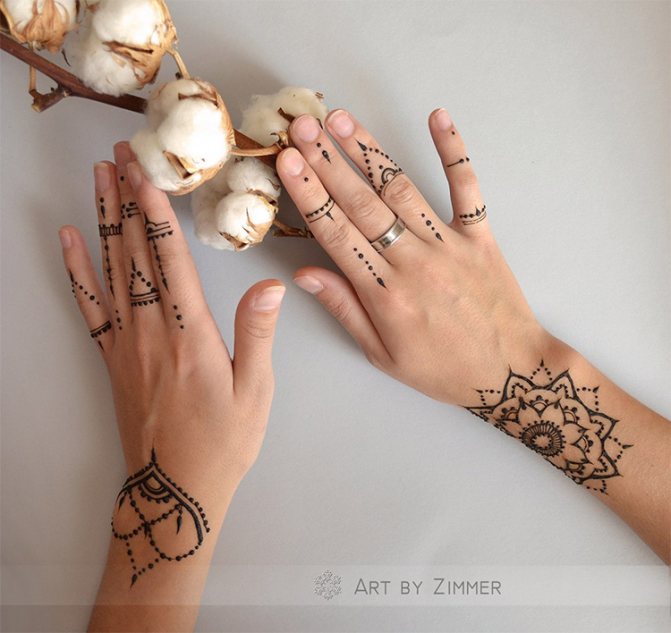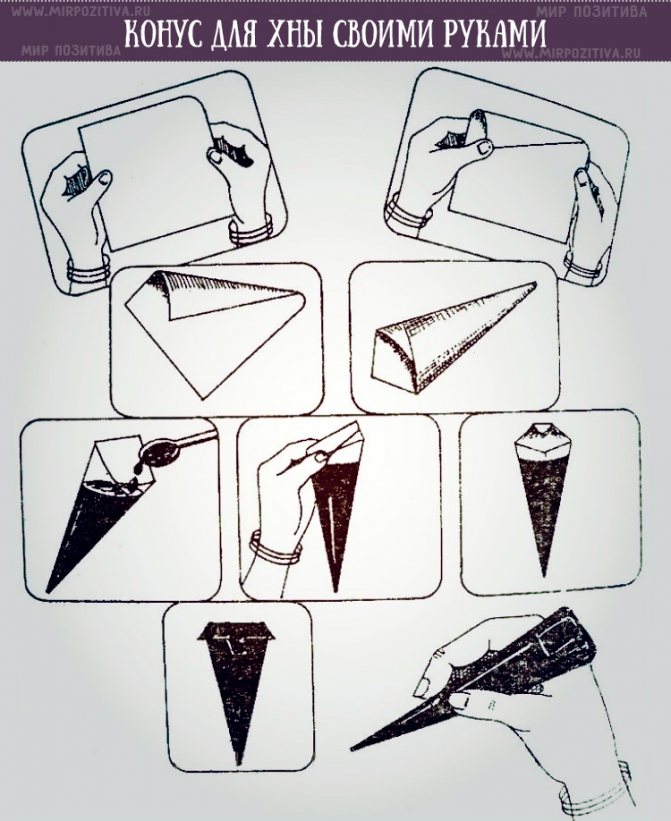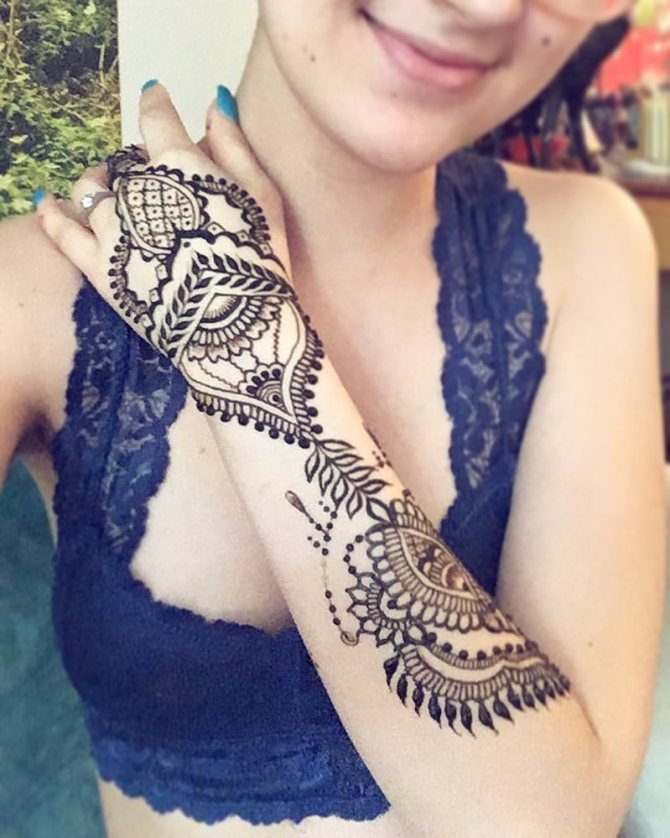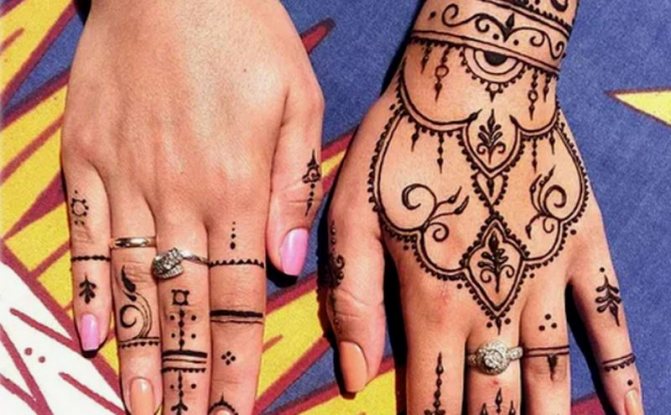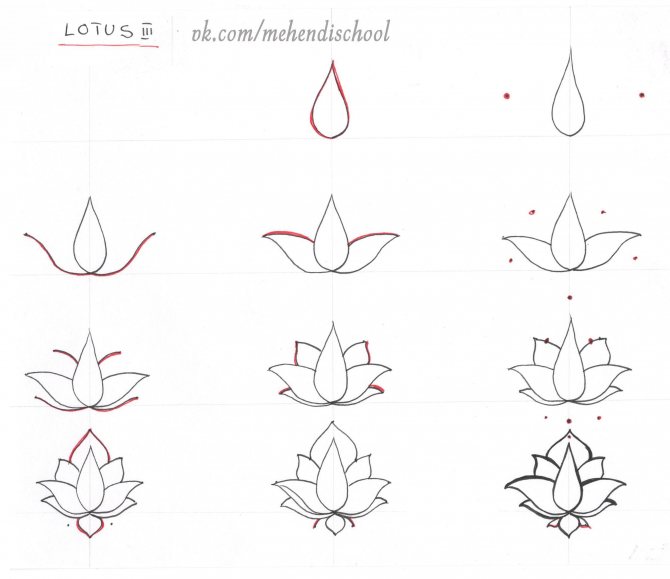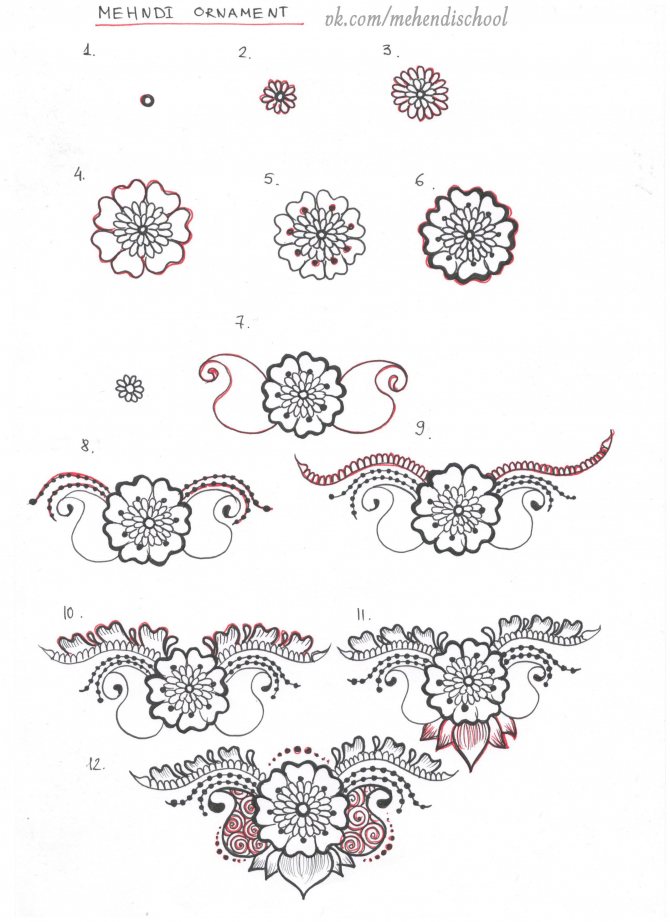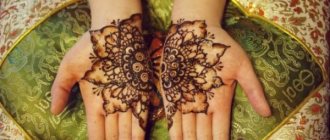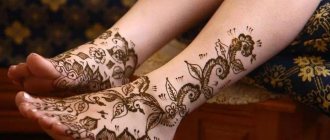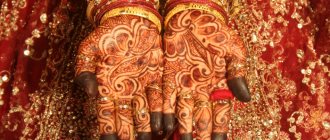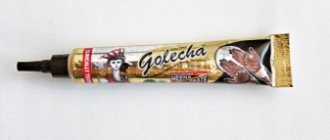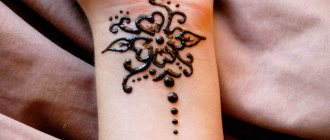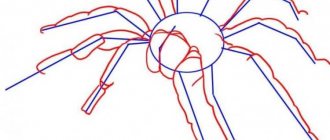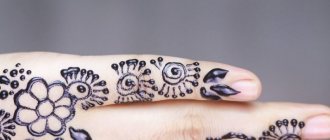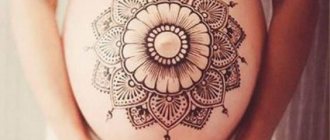Ah, this mysterious word mehendi. Have you ever heard it? If not, we'll introduce you to it. But even if you consider yourself a connoisseur, you'll still learn a thing or two about it from us.
Mehendi (sometimes called mendi) is a body painting using henna paste. Sometimes, this type of body decoration temporary patterns called biotatu.
The desire to look beautiful and to decorate yourself to a certain extent peculiar to all people. The fashion for henna painting came to us from the Eastern and Arab countries. And although today many people associate mehendi with India, the researchers think that it was born in Egypt. The bodies of noble women there were decorated with henna paintings long before our era.
But in India, mehendi became popular only nine centuries ago. It became part of important ceremonies and had a deep religious meaning. For example, the bride's hands and feet were generously covered with an intricate pattern. At this time, the girl was told about the mysteries of married life. Often this conversation and drawing could last from several hours to several days. The remaining paste was necessarily buried to protect the young family from bad luck.
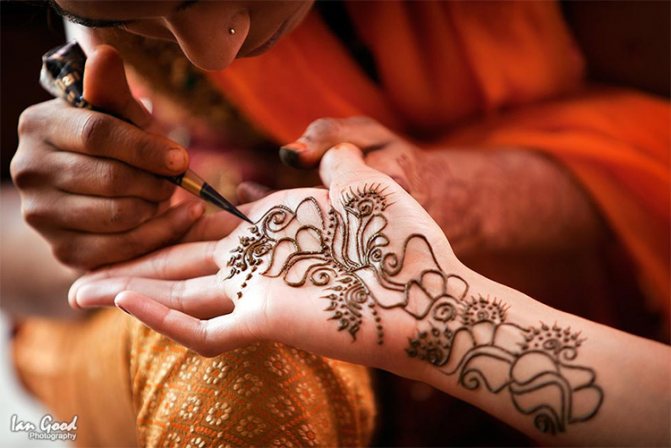
In some countries, brave warriors covered their bodies with patterns, in order to get protection from higher powers in the upcoming battle. Even mysterious patterns were attributed a role of a kind of amulets from other-worldly forces and evil spirits.
Biotatu is popular even today. Representatives of both sexes decorate their bodies with a scattering of openwork patterns. But almost no one is looking for the sacred meaning of the drawings anymore.
The painting, applied with a henna-based drawing paste, usually lasts on the body from a week to a month. After that, the pattern disappears without a trace. Therefore, mehendi is a great option for those who are hesitant to apply a permanent tattoo.
Drawing does not cause any discomfort. Henna itself is an excellent anti-inflammatory and antiseptic agent, it does not harm the skin. That is why progressive mothers are not afraid to apply mehendi even to little girls.
Indian and oriental culture put a certain sense not only in the drawings, but also in the places where they are applied. It is believed that only certain parts of the body have power. Exactly those parts of the skin where most nerve endings are gathered are suitable for drawing patterns with ritual meaning. It is not necessary to be a symbol of the body, but it is important to remember that it is the only place where the nerve endings are accumulated.
The patterns with special or innermost meaning are most often decorated on the wrists, palms and fingers.
What is mehendi and how this art appeared
Mehendi is a henna painting. It can be placed on various parts of the body such as the arms, shoulders, legs, back and abdomen. The tradition of decorating yourself with exquisite ornaments appeared in India and the Middle East. At first, craftsmen and amateur amateurs drew henna on women's legs, and then began to apply the patterns on other parts of the body. And for unmarried girls, mehendi was forbidden. At the same time, in India, the wedding ceremony was closely intertwined with the tradition of decorating the bride with henna drawings. Before the wedding, the groom presented his future wife with a gift - a box of henna. And on the eve of the celebration, the female half of the family would draw intricate pictures on the bride's hands and feet, which carried secret messages to the future spouse and were considered sacred. The Indian wedding was celebrated as long as the mehendi on the bride's body remained intact.


Often Indian and Arabian patterns seem similar, but on closer examination, you can see the differences. The Arabian designs are dominated by floral motifs that cover the entire hand. Indian craftsmen like to depict animals, and most often they are either stylized elephants, symbols of prosperity, or peacocks, symbols of beauty.
On the feet
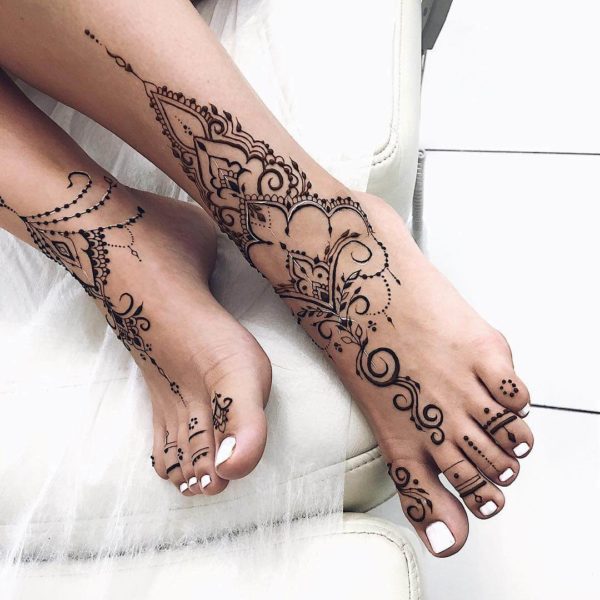

Painting on the legs adds grace and sophistication, especially when such romantic, flowing drawings are taken as the basis.
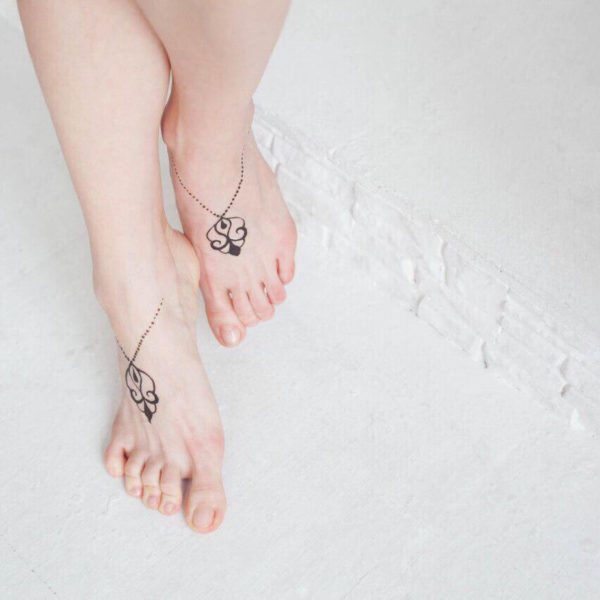

A simple mehendi on the legs in the form of a pendant.
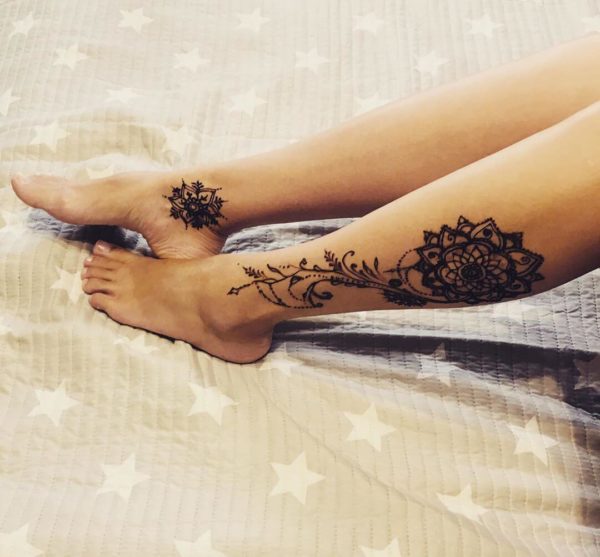

A flower with an ohm-shaped boute, complete with dots and leaves.
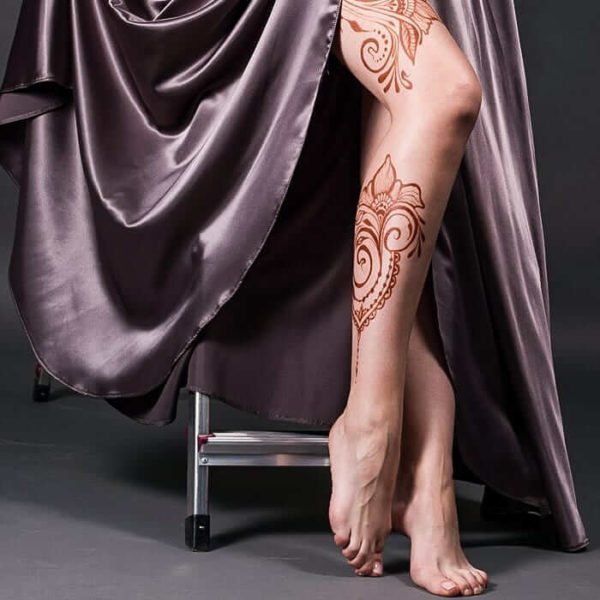

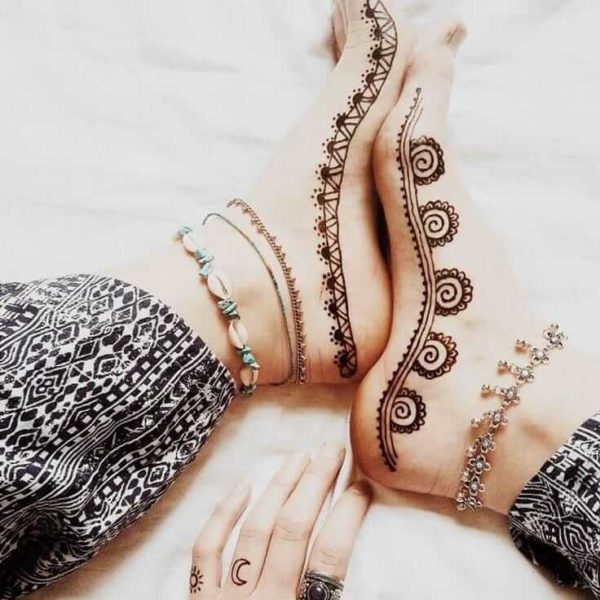

An interesting asymmetrical version of mehendi on the feet.
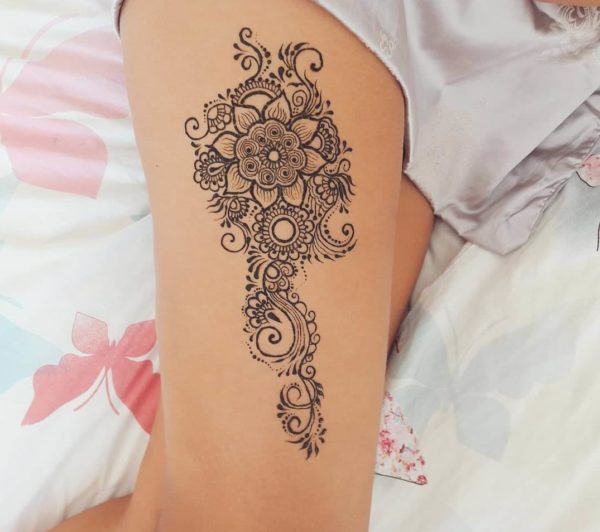

Mehendi on the hip.
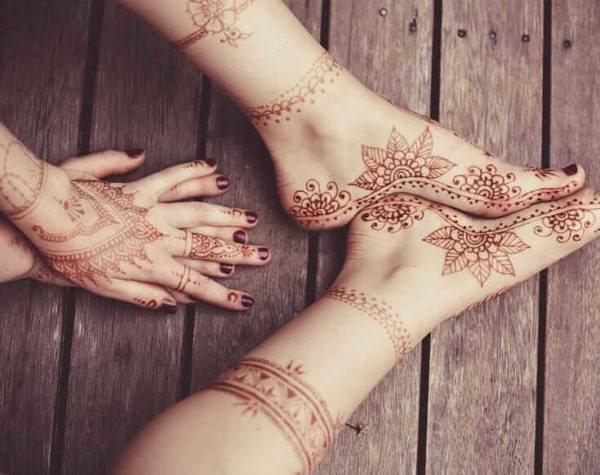

Spa Pedicure - description of all types and technologies
Meaning of the symbols in mehendi drawings
The art of drawing henna on the body has its roots in the distant past and is closely connected with the beliefs of eastern peoples. Geometric ornaments, floral patterns, images of animals painted on the body served as a kind of amulets. Therefore it is not surprising that the elements of mehendi are deeply symbolic and can contain secret messages, understandable to those who can "read" them.
Here is what the most popular symbols in mehendi mean:
- Peacock - beauty;
- Swan - success;
- Bird - messenger between heaven and earth;
- Butterfly - changes to come;
- Parrot - ambassador of love;
- Dragonfly - renewal, rebirth;
- Fish - women's eyes;
- Scorpio - love and romance;
- Elephant - greatness, prosperity;
- Flower - joy and happiness;
- Leaves and vines - longevity, loyalty, vitality;
- Turtle - protection and fertility;
- Snake - enlightenment;
- Ivy - financial well-being;
- Flowering lotus - beauty, grace, sensuality, purity, femininity;
- Sun, moon and stars - lasting deep feelings between two committed partners;
- Cucumber - wealth and good luck;
- A bud, a bud - the beginning of a new life (usually after a wedding);
- The ripple - water, which cleanses and brings new life;
- Square - healing from illnesses;
- Triangle - protection of body and spirit;
- Circle - stability in life;
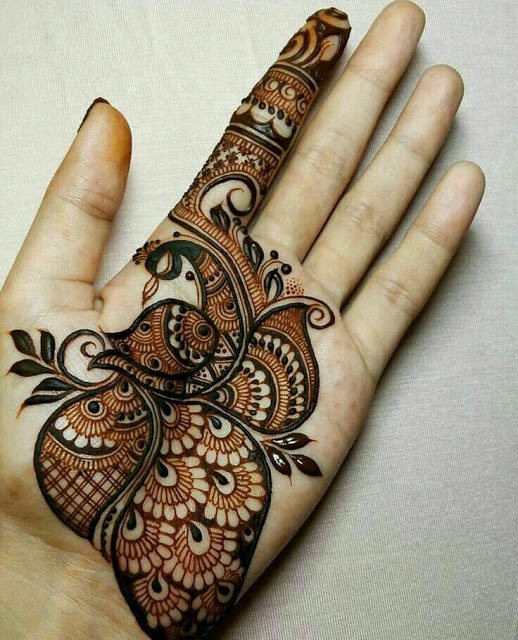

Other pattern placement options
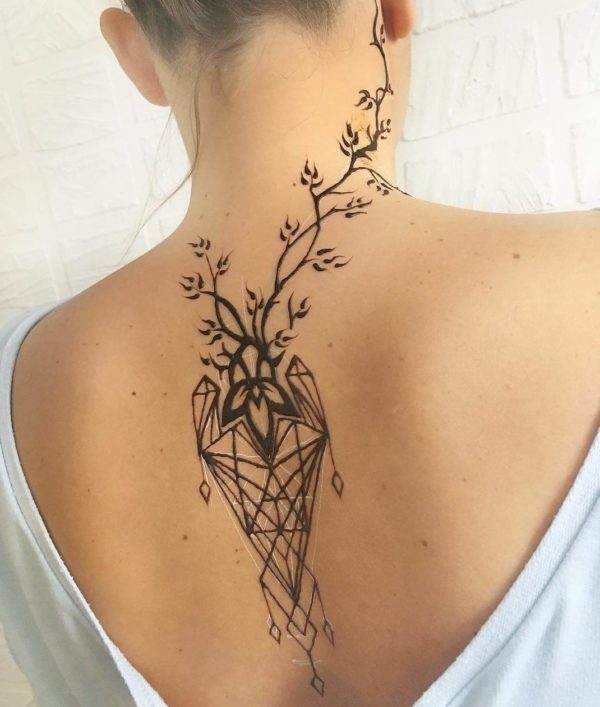

A simple geometric mehendi between the shoulder blades on the back.
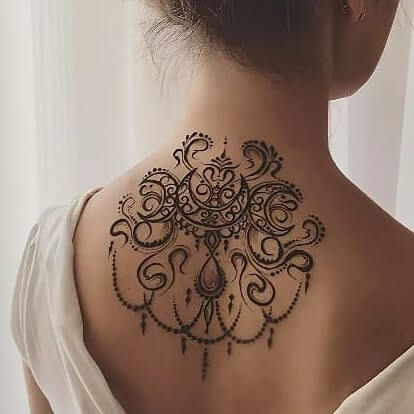

Floral mehendi under the collarbone.
Comment
Benefits of mehendi over regular tattoos
Traditional tattoos and henna drawings are one of the varieties of human body decoration, but mehendi has a number of undeniable advantages over tattoos:
- If you want to get yourself a tattoo but are in doubt about which design to choose, you can get a henna mehendi for two to three weeks. During this time, you will understand if you even want to have a drawing on your body, and if you like the one you choose.
- People with a low pain threshold, who also dream of a tattoo, but are panically afraid of pain, can draw with henna. It is absolutely painless and even pleasant.
- Those who fear infection when applying a traditional tattoo, can also try this alternative.
- Parents whose teenage children are asking permission to do their own tattoos, can offer their child mehendi to begin with. After all, the henna drawing will disappear after a certain amount of time, and with a tattoo, especially a bad one, they'll have to move on with their lives.
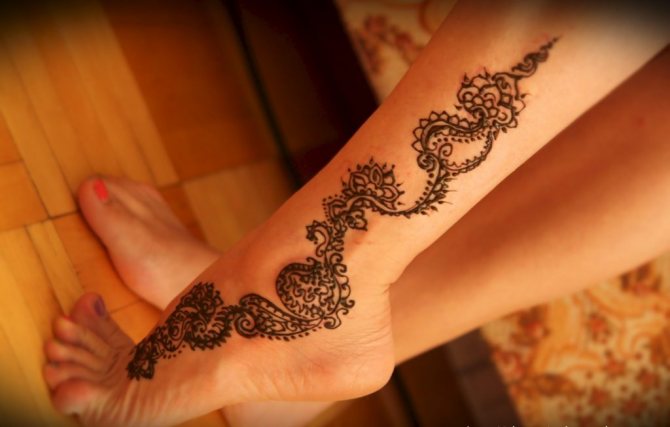

Junior Mistress (2019).


Young Meher Dhillon lives with her widowed mother and brothers in a small Punjabi town. She is in love with Manav, a handsome and educated but poor guy who works in a restaurant. The young people dream of getting married, but the heroine's overbearing mother has found a better match for her daughter. Sarabjit Gilla, a young, honest politician, has recently become a widower and is unable to raise his children without a woman's hand. With whom is the beautiful Meher destined to find happiness?
See also: The 25 best TV series of 2019
Trailer
Original title: Choti Sarrdaarni Genre: Drama Actors: Nimrit Ahluwalia, Avinesh Rekha, Kevina Tak... Country: India RatingIMDb : 5.3
Types of henna for painting mehendi
There are two types of henna for tattooing: store-bought and homemade.
Ready-made artificial mixture contains synthetic dyes, which often cause allergic reactions on the skin of the hands and feet. Therefore, before drawing on the body, you should check how the skin reacts to the composition of the dye. Apply a small amount of henna to the palm or back of your hand and observe how your skin will behave. If the henna application makes your skin itchy or "burns," you should remove it immediately and apply a soothing cream to the irritated area.
In this case, we can advise you to prepare your own mixture for applying mehendi. The paint will be natural and will not cause discomfort in the area where the tattoo is applied.
Natural henna can be distinguished by color: all colors that have a shade other than orange or brown, artificial. Such compositions are not used for applying mehendi to pregnant women and children under 14 years.
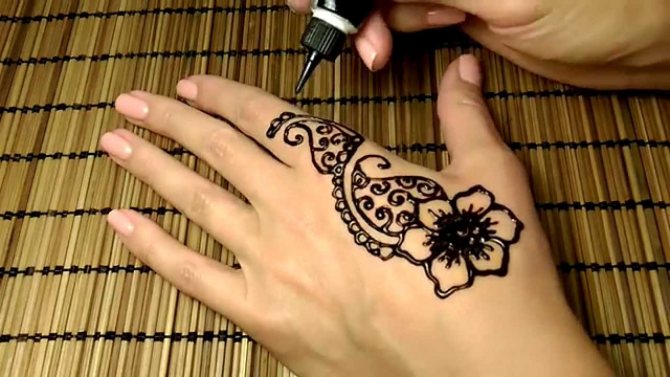

Gangster Begusarai (2015).


Pulan and Bushan began their criminal career as children, when they were forced to plunder under their own mother's guidance for food. Growing up, the brothers became rich and gained unlimited power over the village of Begusarai. In order to avoid future conflicts, the brothers divided the inheritance equally between their sons Lakhan and Priyem. But the caring fathers could not foresee that the cousins' rivalry would erupt for another reason - because of the beautiful Punam.
Trailer
Original title: Begusarai Genre: Action, Drama Actors: Shweta Tiwari, Shivangi Joshi, Sartaj Gill Country: India Rating :IMDb : 6.7 Age restrictions: 12+
How to prepare mehendi paint at home
The mixture for body painting can be prepared by yourself. You will need the following ingredients:
- 500 ml of water;
- 2 tsp. natural ground coffee;
- 2 tbsp. of black leaf tea;
- 100 gr. of natural henna, which is sold in pharmacies or by mehendi masters;
- 2 tsp. lemon juice
- 1 tsp. granulated sugar, which can be replaced with fructose or powdered sugar. They will make the mixture thick and it will be easy to apply to the skin;
- 5 drops of any essential oil. It can be clove, eucalyptus, lavender or tea tree. You can use only one oil, or you can use 2-3 in combination with each other.
It should be noted that henna for painting is used special, so the store henna for hair coloring is not for mehendi.
For the preparation of the mixture is not suitable metal utensils, because the mixture will simply stain them. It is better to take a glass bowl for kneading, and a spoon for stirring - a plastic one.
Preparation:
- Place tea and coffee in a pot of water and boil for 1 hour.
- The resulting decoction strain. Put the grounds in a bowl to prepare the mixture.
- Add henna, oil and sugar to the grounds, mix everything thoroughly.
- Spread the mehendi paint on cones made of foil. Keep the mixture in the refrigerator for 4 months.
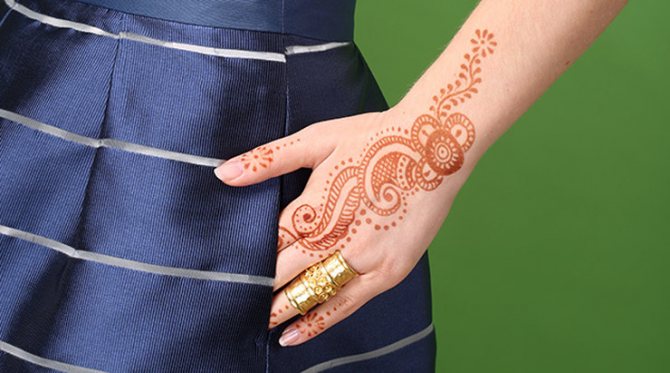

Loneliness (2017).


The characters in the drama series Haider and Mina are young and beautiful, but each has a bleeding wound in their souls. Haider lost his best friend, whose death he blames himself for, and Mira still can't come to terms with the loss of her parents, who died in a car accident. The young people meet at their best friends' wedding, where they try their best to portray fun and serenity. There is a spark between Mina and Haider that could grow into a love fire. But will it become a cleansing fire that overcomes the characters' usual loneliness?
Trailer
Original title: Tanhaiyan Genre: Melodrama Actors: Barun Sobti, Surbhi Jyoti, Mohit Abrol Country: India Rating: IMDb - 7.9
How to hold a henna cone properly while painting
For those who are just beginning to learn the ins and outs of body painting, it is very important to learn how to hold the henna cone correctly. If the hand is uncomfortable, it will quickly get tired, and the lines will turn out uneven.
- Before working with a cone with a henna need to cut off the tip, from which in the process of work will leak paint. If the tip of the cone is dirty and the henna comes out of it with difficulty, it must be cleaned with a paper napkin.
- The whole hand or the edge of the palm should be rested on the table when painting the hands or on the body when painting the abdomen or back.
- The paint cone should be placed between your thumb and index finger, 4 cm from the tip of the cone. The thumb holds the cone in the hand, and it also regulates the intensity of the paint squeeze. Otherwise it will be squeezed out of the cone unevenly, which will spoil the whole work.
- The rest of your hand is relaxed so you can control the process of drawing freely.
- The tip of the cone rests on the middle finger of the hand, and the index finger presses the cone on top. For the convenience of drawing, you can additionally lean on the free little finger.
- One should not pinch the tube with paint in the fist, because in that case the hand is too strained, and the drawing comes out smeared.
- When drawing, the cone should be perpendicular to the surface of the drawing. In this way all the elements of mehendi are performed.
- Holding the cone at an oblique angle, you can only outline the future drawing or draw fine straight or wavy lines.
- During mehendi drawing the cone should be held at a small distance from the surface of the skin, so that the henna flows out freely and lies evenly. If you lead the cone, pressing it to the surface, the drawing will be smeared and the skin will be scratched.
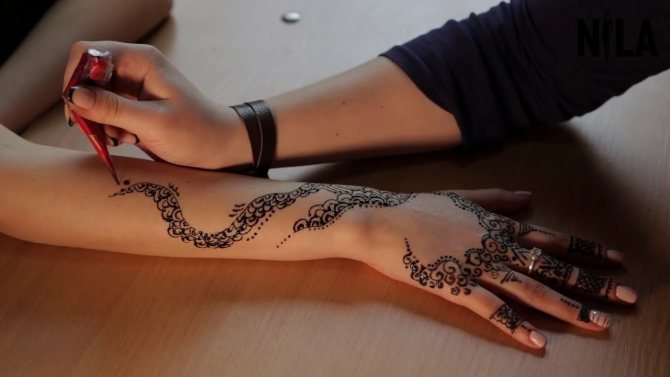

This Wish (2019)


The multiseries melodrama about a rock star was doomed to make it to the top of Indian love series. When Dr. Prisha's sister died in childbirth, the girl, without a second of doubt, adopted her newborn nephew Sansha, making her own life rather difficult. Her mother does not approve of such an act and explicitly says that no one would marry a single mother, but such a man is found - Pricha's hand requests the hand of a worthy man, lawyer Yuvraj. But into her life suddenly bursts rock singer Rudraksh, whose songs are adored by the grown-up Sansh. Who will Prisha choose?
Indian Movies - 10 Best Melodramas
Trailer
Original title: Yeh Hai Chahatein Genre: Drama Actors :Sargun Kaur Luthra, Abrar Qazi, Aishwarya Sakhuja Country: India RatingIMDb : 7.4
Stages of mehendi
The process of henna body painting consists of several stages:
- Preparation of the skin for the drawing. First you need to clean the place of the future image and moisturize it with any essential oil. Then apply lemon juice on a cotton pad and wipe the surface to make the drawing more vivid.
- The first mehendi is easier to draw, using special stencils. You can buy them in a store, or you can make yourself from self-adhesive tape. After the skin is prepared for drawing, it is necessary to glue the stencil. If drawing is done according to a previously prepared sketch, it is possible to outline the image with thin lines, which are applied at an oblique angle of the cone to the surface of the skin.
- The next stage is the drawing itself. Using the correct position of the cone in the hand, a thick layer, without scratching the skin, is drawn with henna. If a mistake is made during drawing, the paint can be removed with a cotton swab moistened with hydrogen peroxide.
- After the work is completed, the stencil is removed and the mehendi is left until the paint dries completely. In 15-20 minutes, the henna begins to dry and crumble, and the skin remains imprinted pattern. The crusts are easily removed with a paper napkin. Under no circumstances should they be washed off with soapy water. This will lead to discoloration of the pattern. At this time you can apply a mixture of lemon juice and sugar to the tattoo, it will moisten and become even darker. Although you can reapply a layer of paint, with the same goal of making the design brighter.
- After the paint is completely dry and any henna residue is removed, the drawing is moisturized again with oil or cream, because dried henna tends to shrink the skin.
- The color of the mehendi shows up within 24-72 hours after applying it to the body.
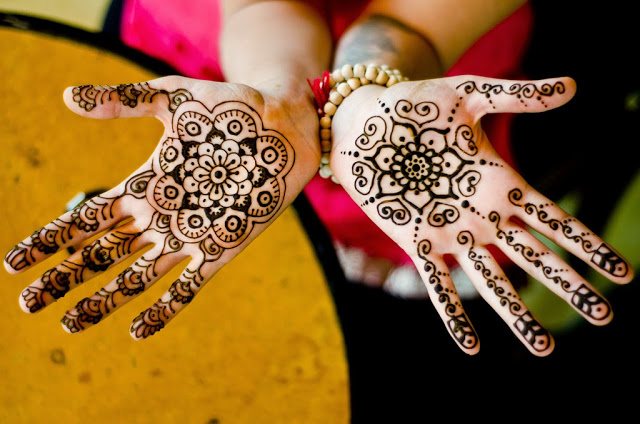

Sita and Rama (2015 - 2016)


The adaptation of the ancient Indian epic "Ramayana" deservedly leads the list of the best Indian series. A ruler of the kingdom of Videha named Janaka is extremely concerned about a 12-year drought in his lands and childlessness. Following his guru's advice, Janaka casts a plow of gold and plows the soil himself, in which he finds a basket containing baby Sita. At that moment, a bountiful downpour begins and the beautiful girl's long life, filled with trials and great love for King Rama, the incarnation of the supreme deity on earth.
Trailer
Original title: Siya Ke Ram Genre: History, Melodrama Actors: Madirakshi Mandla, Ashish Sharma, Karan Suchak Country: India Rating :: Kinopoisk - 7.6, IMDb - 7.4
How to remove a henna tattoo
The red-brown color of mehendi, depending on the quality of the henna, remains on the body for 1-3 weeks. During this time, the design can be wet, but do not rub it too hard with a scrub or sponge.
Over time, the mehendi will fade and you will probably want to remove it. This can be done in the following ways:
- Wipe off the remnants of the design with a cotton pad soaked in alcohol or hydrogen peroxide;
- Wash your hands thoroughly with a sponge and soap;
- apply toothpaste to the mehendi and rub it well, then rinse it off with water;
- mix baking soda with lemon juice, apply the mixture to the drawing and leave it to dry. Then wash your hands with warm water.
After removing the henna drawing, it is advisable to treat the skin with moisturizing cream or essential oil, as all methods of mehendi removal dry the skin.
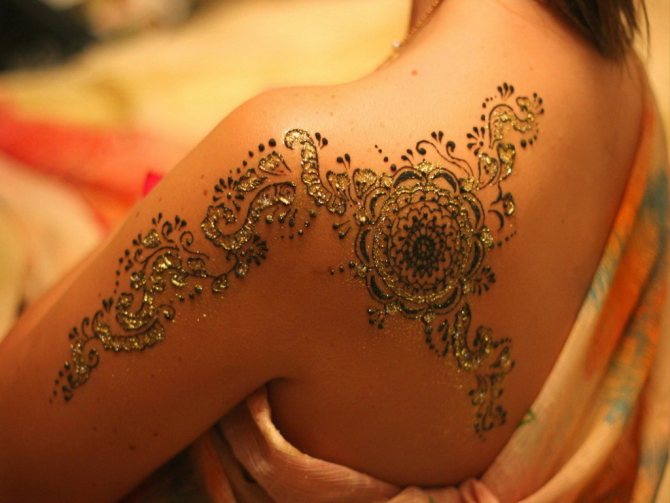

Pure Love (2018)


Young Muslims Zara and Kabir are educated and modern, but their views on life are diametrically opposed. Zara is a fighter for women's rights and freedom, while Kabir is an ardent adherent of Shariah. Despite their irreconcilable contradictions, between fierce arguments the boy and the girl fall in love with each other and even manage to get married. But family life has not made the spouses like-minded; the newlyweds' conflicts continue even into their honeymoon. Will the young eventually find common language and reach the family harmony?
Trailer
Original title: Ishq Subhan Allah GenreDrama, Melodrama Actors: Eisha Singh, Adnan Khan, Ankit Vyas Country: India RatingIMDb : 6.3 Age restrictions: 16+
Tips for beginners
Every mehendi master has his own secrets on how to prepare the mixture for the drawings on the skin, on the technique of applying the image and on how to take care of it. Here are just a few of them:
- On different parts of the body, the intensity of mehendi color varies. The drawings on the palms of the hands are always very dark, even black, while on the back, on the contrary, they are lighter. Also less intense color is given by henna on the forearms and legs.
Natural henna powder has a pronounced herbal smell and a green color, and the mixture for drawing from it turns out brown or orange. In no case should it be black.
- Before you start drawing mehendi on your skin, you should practice the individual elements of the patterns and determine the correct position of the henna cone in your hand. It is best to practice on a piece of paper first. Don't spare the henna, buy one tube of henna specifically for training and use it at once to "put your hand". When you can draw more or less neat lines on paper, you can try to doodle on any glass surface. The more you practice, the harder your hand will be, the clearer the lines and the neater the patterns.
- The art of mehendi should start with the simplest images consisting of straight and wavy lines, peas and geometric shapes. With time, you can learn to do more advanced patterns.
- If you are not allergic to the purchased mehendi mix, you can safely use it for painting. Especially because the artificial henna has a huge number of colors: black, blue, green, cherry and so on. However, keep in mind that drawings made with natural paint, prepared by yourself, retain their brightness longer.
- If you are drawing yourself, for example, on your hand, then you should move from the farthest point to yourself, i.e. from fingers to wrist. Similarly, if you are drawing on the body of another person, move in mehendi drawing from the farthest edge to yourself. If it is a hand, from the wrist to the fingertips.
- The henna-based drawings are completely dry in a few hours. Here it all depends on the composition of the mixture for drawing. For a brighter and longer lasting tattoo, allow 6-8 hours for the henna to dry. You can do mehendi in the evening and leave it overnight. This way the drawing will be more saturated. Again, for the first few hours, the tattoo will not be in contact with water, which is also good for mehendi.
- The duration of the henna drawing depends on many factors: the quality of the mixture for drawing, and the drying time of mehendi and care for it. As for the skin type, in this case, the lucky girls with dry skin, because they have henna tattoo lasts much longer. Also important is the location of the image: on the hands and feet mehendi retains its brightness longer, because these parts of the body are warm and slightly moist. As for the climate, this kind of decoration likes warmth.
Traditional mendi painting in different countries of the world
In each country and even in a particular region of the state, this type of body decoration has acquired its own distinctive characteristics:
- Middle East. For example, Bedouins who spend most of their lives in the desert may not create patterns at all, but simply dip their palms and feet in henna. In everyday life, the Arabs often do not perform complicated drawings, but in preparation for ceremonies, they apply more intricate patterns - usually represented by plant motifs.
- Malaysia. Mendi is often a ritual decoration for the bride before her wedding.
- North Africa. African culture loves the clarity of outlines, the drawing of each element, so they prefer to use strict geometric shapes in henna painting.
- Indonesia. Here they prefer plant motifs, similar to traditional Indian patterns. Sometimes the sides of the feet and palms, the pads of the fingers are painted completely.
- India. What patterns can be found here! The variety is simply breathtaking. Before the wedding, brides are sure to have complex and large patterns from their feet to their knees, as well as from the palms of their hands to their forearms. Different symbolism is used for mendi. They like to paint the body in openwork ethnic patterns and add images of lotus, elephant, peacock, etc. Each symbol is given a different meaning.
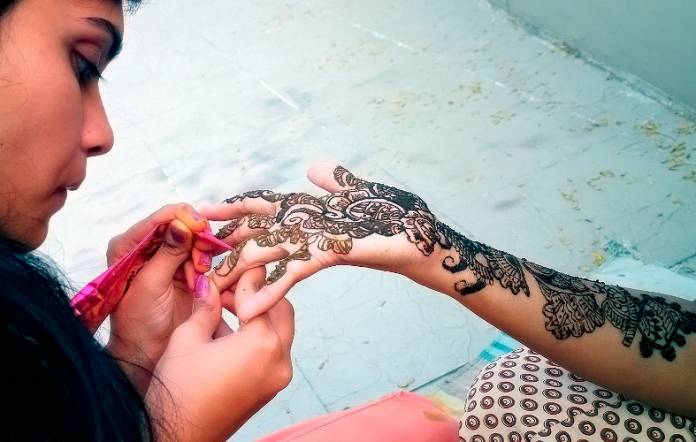

Process of henna application
In European countries for a long time mendi as an art and decoration was denied. This was probably because of the negative attitude of Christianity towards the "pleasures of the flesh. But today the situation is changing dramatically and even celebrities are allowed to paint their bodies with henna. Just look at the amazing mendi designs!
Beautiful, but simple mehendi that even beginners can handle
Favorite Son-in-Law (2014 - 2016)


Energetic and independent, Roshni Patel believes that everyone deserves happiness and puts her beliefs into practice by working in an orphanage. After discovering that the orphans might be left homeless at the whim of a land developer, Roshni decisively goes to the company owner, Siddharth Khuran. It turns out that the young man is unaware of his deputy's self-serving plans and learns the truth about the intrigue from Roshni. In addition to gratitude, Sid feels something more for the angry guest.
Trailer
Original title: Jamai Raja Genre: Drama Actors: Ravi Dubey, Nia Sharma, Achint Kaur Country: India RatingIMDb : 5.6 Age Rating : 5.6: 12+
Jodha and Akbar: A Great Love Story (2013 - 2015)


Despite some fabulousness, the plots of Indian TV series are often based on real historical events, just like this movie. The people of sixteenth-century India practiced Hinduism and Islam, living peacefully side by side. But when an army led by Akbar, famous for his victories, approaches the country, the Hindus are threatened with expulsion by the Muslims from their homeland. The beautiful Rajput princess Jodha, risking her freedom and life, enters into negotiations with Akbar, beginning a story of great love.
Worth watching: The 25 Best War Series
Trailer
Original title: Jodha Akbar GenreMelodrama, History Actors: Pranav Mishra, Naved Aslam, Kunal Bhatia Country: India Rating: Kinopoints - 8.6, IMDb - 5.8 Age restrictions: 12+

